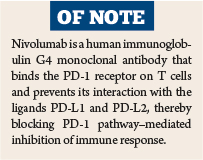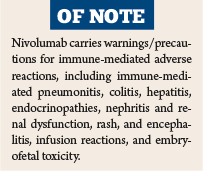On January 23, 2016, the indication for nivolumab (Opdivo) plus ipilimumab (Yervoy) in unresectable or metastatic melanoma was expanded through accelerated approval to include patients regardless of BRAF V600 mutation status.1 The combination was previously approved for treatment of patients with BRAF V600 wild-type disease in October 2015. Nivolumab is also approved for use as a single agent in unresectable or metastatic melanoma in both BRAF-mutant and BRAF–wild-type disease. Continued approval for the combination treatment may be contingent upon verification and description of clinical benefit in confirmatory trials.
Supporting Efficacy Data
The expanded indication is based on findings in a double-blind phase III trial (CheckMate 067) in which 945 patients previously untreated for advanced disease were randomized 1:1:1 to receive nivolumab at 1 mg/kg with ipilimumab at 3 mg/kg every 3 weeks for four doses followed by nivolumab at 3 mg/kg as a single agent every 2 weeks (n = 314), nivolumab at 3 mg/kg every 2 weeks (n = 316), or ipilimumab at 3 mg/kg every 3 weeks for four doses followed by placebo every 2 weeks (n = 315).1,2 Patients had to have completed adjuvant or neoadjuvant treatment at least 6 weeks prior to randomization; had no prior treatment with an anti–CTLA-4 (cytotoxic T-lymphocyte–associated antigen) antibody; and had no evidence of active brain metastasis, ocular melanoma, autoimmune disease, and conditions requiring systemic immunosuppression. Patients had a median age of 61 years (range = 18–90 years), 65% were male, and 97% were white. In addition, Eastern Cooperative Oncology Group performance status was 0 for 73% and 1 for 27%, 93% had stage IV disease, 58% had M1c disease, 36% had elevated lactate dehydrogenase, 4% had a history of brain metastases, 46% had PD-L1 (programmed cell death protein 1) expression ≥ 5%, 22% had prior adjuvant therapy, and 32% had BRAF V600 mutation–positive disease.

Investigator-assessed progression-free survival was 11.5 months in the combination group (hazard ratio [HR] = 0.42, P < .0001, vs ipilimumab) and 6.9 months in the nivolumab group (HR = 0.57, P < .0001, vs ipilimumab) vs 2.9 months in the ipilimumab group. Objective response rates were 50% and 40% vs 14% (both P < .0001). An exploratory analysis showed no difference between the combination group and the single-agent nivolumab group in progression-free survival for patients with PD-L1 expression ≥ 1% but better outcome with the combination among those with expression levels < 1% (HR = 0.58, 95% confidence interval = 0.41–0.81).
How It Works
Nivolumab is a human immunoglobulin G4 (IgG4) monoclonal antibody that binds the PD-1 receptor on T cells and prevents its interaction with the ligands PD-L1 and PD-L2, thereby blocking PD-1 pathway–mediated inhibition of immune response, including antitumor immune response. Binding of PD-L1 and PD-L2 to the PD-1 receptor inhibits T-cell proliferation and cytokine production. Upregulation of PD-1 ligands occurs in some tumors, and signaling through this pathway can contribute to inhibition of active T-cell tumor immune surveillance. In syngeneic mouse tumor models, blocking PD-1 activity results in decreased tumor growth. Combined PD-1 inhibition with nivolumab and CTLA-4 inhibition with ipilimumab produces enhancement of T-cell function that is greater than with either agent alone, resulting in improved antitumor responses in metastatic melanoma. In murine syngeneic tumor models, dual blockade of PD-1 and CTLA-4 resulted in increased antitumor activity.
How It Is Used
The recommended dose of nivolumab in this setting is 1 mg/kg via intravenous (IV) infusion over 60 minutes, followed by ipilimumab on the same day, every 3 weeks for 4 doses. The recommended subsequent dose as a single agent is 3 mg/kg via 60-minute infusion every 2 weeks until disease progression or unacceptable toxicity.
Expanded Indication for Combination in Melanoma
- The indication for nivolumab (Opdivo) plus ipilimumab (Yervoy) in unresectable or metastatic melanoma was expanded through accelerated approval to include patients regardless of BRAF V600 mutation status. The combination was previously approved for treatment of patients with BRAF V600 wild-type disease.
- The recommended dose of nivolumab in this setting is 1 mg/kg via intravenous infusion over 60 minutes, followed by ipilimumab on the same day, every 3 weeks for 4 doses.
Nivolumab treatment should be withheld for grade 2 pneumonitis, grade 2 or (when used as single agent) grade 3 diarrhea or colitis, alanine transaminase (ALT) or aspartate transaminase (AST) > 3 to 5 times the upper limit of normal (ULN) or total bilirubin > 1.5 to 3 times ULN, serum creatinine > 1.5 to 6 times ULN, grade 2 or 3 hypophysitis, grade 2 adrenal insufficiency, grade 3 hyperglycemia, grade 3 rash, new-onset moderate or severe neurologic signs or symptoms (potential immune-related encephalitis), and first occurrence of other grade 3 adverse reactions. There are no recommended dose modifications for hypothyroidism or hyperthyroidism. Ipilimumab should be withheld when nivolumab is withheld.
Nivolumab should be permanently discontinued for grade 3 diarrhea or colitis in combined use, grade 4 diarrhea or colitis, grade 4 hypophysitis, grade 3 or 4 adrenal insufficiency, grade 4 hyperglycemia, grade 4 rash, grade 3 or 4 pneumonitis, AST or ALT > 5 times ULN or total bilirubin > 3 times ULN, serum creatinine > 6 times ULN, immune-mediated encephalitis, recurrence of grade 3 adverse reaction, life-threatening or grade 4 adverse reaction, requirement of ≥ 10 mg/d of prednisone or equivalent for > 12 weeks, and persistent grade 2 or 3 adverse reactions lasting ≥ 12 weeks.
Infusion should be interrupted or slowed in patients with mild or moderate infusion reactions. Nivolumab should be discontinued for severe or life-threatening infusion reactions.
Safety Profile
In the phase III trial, the most common adverse events of any grade in the combination group were fatigue (59% vs 53% in nivolumab group and 50% in ipilimumab group), rash (53%, 40%, 42%), diarrhea (52%, 31%, 46%), nausea (40%, 28%, 29%), and pyrexia (37%, 14%, 17%). Grade 3 or 4 adverse events occurred in 72% of the combination group and 44% of the single-agent nivolumab group, with the most common including diarrhea (11%, 4%, 8%), fatigue (6%, 2%, 4%), and rash (5%, 2%, 4%). Serious adverse events occurred in 73% of the combination group and 37% of the single-agent nivolumab group, with the most common being diarrhea (13% and 2.6%), colitis (10% and 1.6%), and pyrexia (10% and 0.6%).

Adverse events led to permanent treatment discontinuation in 43% of the combination group and 14% of the nivolumab group and to dosing delay in 55% and 28%. The most frequent adverse events leading to discontinuation of both drugs in the combination group and of nivolumab in the single-agent group were diarrhea (8% and 1.9%), colitis (8% and 0.6%), increased ALT (4.8% and 1.3%), increased AST (4.5% and 0.6%), and pneumonitis (1.9% and 0.3%). The most common grade 3 or 4 lab abnormalities in the combination group were increased lipase (20%, 9%, 7%), increased ALT (15%, 3%, 3%), increased AST (13%, 4%, 2%), hyponatremia (9%, 3%, 7%), and increased amylase (9%, 2%, 2%).
Report Adverse Events
Health-care professionals should report all serious adverse events suspected to be associated with the use of any medicine or device to FDA’s MedWatch Reporting System by completing a form online at http://www.fda.gov/medwatch/report.htm, by faxing (1-800-FDA-0178), by mailing the postage-paid address form provided online, or by telephone (1-800-FDA-1088).
Nivolumab carries warnings/precautions for immune-mediated adverse reactions, including immune-mediated pneumonitis, colitis, hepatitis, endocrinopathies, nephritis and renal dysfunction, rash, and encephalitis, infusion reactions, and embryofetal toxicity. Patients should be monitored for changes in liver, kidney, thyroid, and neurologic function and for hyperglycemia. Breastfeeding women should discontinue breastfeeding when receiving nivolumab. ■
References
1. Opdivo (nivolumab) injection, for intravenous use prescribing information, Bristol-Myers Squibb Company, January 2016. Available at www.opdivo.com. Accessed February 5, 2016.
2. Larkin J, Chiarion-Sileni V, Gonzalez R, et al: Combined nivolumab and ipilimumab or monotherapy in untreated melanoma. N Engl J Med 373:23-34, 2015.

